Origins
Agnes Pelton was born to American parents in Stuttgart, Germany. Pelton (1881–1961) and her family briefly lived in Basel, Switzerland, before returning to the United States in 1888. She graduated from the Pratt Institute in Brooklyn in 1900, and that same year worked as an assistant teacher at the Ipswich Summer School of Art in Ipswich, Massachusetts. Both programs were shaped by the highly influential arts educator Arthur Wesley Dow, whose students included Georgia O’Keeffe and Charles Sheeler. In 1910, she spent a year studying life drawing at the British Academy of Arts in Rome, and she exhibited in the Armory Show of 1913, at the invitation of painter and art promoter Walt Kuhn.
Pelton’s first encounter with the American Southwest came in 1919 when American arts patron Mabel Dodge Luhan invited her to her home in Taos that served as a retreat for artists, writers, and others involved in creative work. During the 1920s, Pelton matured into an artist whose interpretations of earth and light in biomorphic compositions of delicate veils, shimmering stars, and atmospheric horizon lines distinguished her abstract work and sparked her artistic passion.
Agnes Pelton nació de padres estadounidenses en Stuttgart, Alemania. Pelton (1881–1961) y su familia vivieron brevemente en Basilea, Suiza, antes de regresar a los Estados Unidos en 1888. Se graduó del Instituto Pratt en Brooklyn en 1900 y ese mismo año trabajó como profesora asistente en la Escuela de Verano de Arte en Ipswich, Massachusetts. Ambos programas fueron diseñados por el influyente educador en arte Arthur Wesley Dow, cuyos estudiantes incluyeron a Georgia O'Keeffe y Charles Sheeler. En 1910, pasó un año estudiando dibujo con modelos en vivo en la Academia Británica de Artes de Roma y expuso en el Armory Show de 1913 por invitación del pintor y promotor de arte Walt Kuhn.
El primer encuentro de Pelton con el suroeste de los Estados Unidos ocurrió en 1919 cuando la mecenas estadounidense de las artes Mabel Dodge Luhan la invitó a su casa en Taos que servía como un retiro para artistas, escritores y otras personas involucradas en el trabajo creativo. Durante la década de 1920 Pelton se desarrolló, convirtiéndose en una artista cuyas interpretaciones de la tierra y la luz en composiciones biomórficas de velos delicados, estrellas brillantes y líneas de horizonte atmosféricas distinguieron su obra abstracta y desataron su pasión artística.

The Fountains, 1926, Oil on canvas, Collection of Georgia and Michael de Havenon
Pelton described The Fountains, which features cascading water and an opalescent mist, as an “emanation of pure thought.” For her, water was a symbol of selflessness. Having no shape of its own, but instead assuming the shape of its container, it was the archetypal symbol of acquiescence and acceptance. Not surprisingly for an artist who once wrote that “God is where we summon him when we make a center of receptivity” and who thought of herself less as an active creator than as a vehicle for communicating spiritual union, Pelton often used water as a motif to suggest the benevolence and disembodied energies animating and protecting life, as evidenced by the work’s original title, The Fountains—Love.

Being, 1926, Oil on canvas, Collection of Laurie M. Tisch
The subject matter of Being, Pelton’s first fully abstract painting, was music and its connection to color. Synesthesia—the idea that sound and vision and the other senses could merge to create new sensory experiences—was an idea that interested many artists of her generation. Beyond that, music played a large role in Pelton’s early life. Her mother ran the Pelton School of Music in Brooklyn, and Pelton studied piano throughout her teenage years. Looking back on Being in 1929, she wrote that its dynamism resulted from the “interplay of different color vibrations—colors catching the eye excessively as sequence of sound in music.”
